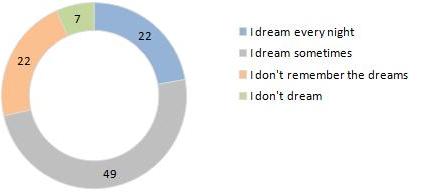In the opinion of some people, dreams are a virtual reality in which we escape for different reasons (especially stress) during the sleep and, in the opinion of others, more superstitious, during sleep we can use more areas of the brain or even make contact with the astral side of life.
Freud said that dreams are a way to express some desires, the most important desire being to continue the sleep. If we are thirsty – we dream we are drinking a glass of water. If we hear some noises, we will continue to sleep, but these noises will become part of our dreams. The great psychoanalyst also said that the dream is a way to explore the unconscious, and that the unfulfilled, censured and unconscious desires appear in our dreams. The forbidden wishes shall appear in dreams, but in a more veiled, metaphorical form. The dreams have a latent content, with hidden senses, and in order to reveal them, an individual psycho-analytical interpretation is needed.
Nevertheless, Freud’s theory was criticized. The latest scientific researches revealed that dreams are intended to help the memory. During our sleep we remember about our recent experiences, organize and internalize them. Depending on the environment in which we live, on the way we react to different positive and negative exciting factors, on our expectations, we have either positive and happy dreams or nightmares. The positive dreams keep us healthy, release us from our frustrations, while nightmares can lead to depressions and other disorders.
As it was determined during the Magenta National Screening research, carried on a sample of 1400 respondents aged 14-65 years from 24 towns, with an error margin of +/-2,6 %, almost half of respondents said they dream only sometimes, every fifth Moldovan has dreams every night, and other 22% don’t remember the content of their dreams. There were also respondents declaring they never dream – 7% from the total sample.
What kind of dreams do those people that always dream have? Sweet dreams or nightmares? We can’t find out this type of information, nevertheless, it can be stated that the brain of these people if very active and they have a life full of positive or negative emotions. But emotions, no matter of their quality are a stress for the body, especially if these emotions are very intense.
Figure 1: How often do you dream? N=1333, %

Who are those who dream more or less?
The multicriterial analysis revealed a reverse dependence between the age and the quantity of dreams seen during sleep. Teenagers dream the most, 37% of them declared having dreams each night, while those under 29 years turned having dreams everyday a little more than the average. Probably it is not said in vain that only children have the capacity to dream, not only figuratively mentioned, but as the study revealed young people dream more, even with their eyes opened.
Those elder than 45 years mostly dream sometimes, this means they dream more seldom. Is it true that with aging we have fewer dreams? The most oblivious persons regarding the content of their dreams are those of 25-29 years old, their mind being too busy to remember also their dreams. Among those who never dream, the largest share is covered by the people aged 45-54 years. Women in a higher degree than men have dreams every night. Is it that men don’t have any dreams? Or maybe men have a more quiet sleep and are more equilibrated, the stress accumulated over the day has less influence on their sweet dreams?
Regarding the marital status of the dreamers, mostly those who are single and live in concubinage dream every day. Probably they dream about family life, because the married ones dream the least.
Untill the middle of the last century it was considered that a person who has colored dreams has a psychological disorder. Actually it is a therapy in colors. Even the idea about black-and-white dreams appeared after the appearance of cinema, television and black-and-white photos. In this way appeared the possibility to overlap the black-and-white picture with the real life, which is reach in colors.
International studies reveal that of those who watched movies in colors in their childhood, only 7% have black-and-white dreams, compared to every fourth person who watched black-and-white movies in his/her childhood.
According to the opinion of other psychologists, black-and-white dreams have those persons predisposed to precise sciences; while creative persons have colored dreams.
In this way it was interesting to find out what are the colors of dreams of Moldavians. The research revealed that every third Moldavian has black-and-white dreams. Might this be an effect of the fact that Moldavians watched too many black-and-white movies in their childhood?
Figure 2 : The color of dreams of Moldavians, N=894, %

The multicriterial analysis showed that half of the persons over 45 years have black-and-white dreams. The large majorityof teenagers and youngster have colored dreams. Also the dreams of singles and those who live in concubinage are colored mostly.
Analyzing the interdependence among colored dreams, health and happiness, it was revealed the fact that those who have colored dreams are healthier and happier.
Therefore we advise you to keep dreaming night and day!
 Download PDF
Download PDF